Table of Contents
Syllogism means making a conclusion or judgment. It’s an important part of logical reasoning and appears in almost all competitive exams like SSC, Railway, Defence, Banking, and Teaching. Syllogism questions can help you score well in the Reasoning section with less practice and effort. You just need basic knowledge and a few tricks to answer these questions accurately. This article will explain what syllogism is, its types, some useful tricks, and the types of questions you might face in exams.
What is Syllogism?
Syllogism can be referred to as an instance of form of reasoning that comes under logical reasoning. This form of reasoning includes statements, conclusions, and then with the help of venn diagrams, the candidates can draw their answers. These statements or conclusions do not need to be true in the real world.
Example: All Cats are animals, all animals have four legs, so, all cats have four legs.
Types of Syllogism in Reasoning
In Reasoning syllogism is of basically four types which are as follows:
- Fundamental Syllogism – In this type of syllogism reasoning, the conclusions must be 100% true always. The conclusions which are 99% true will be considered False.
- Either OR Case Syllogism – In this type of syllogism in reasoning, when the conclusions are not 100% true but the two given conclusions are 50% true then the either-or case will be formed. In it, both the statements should have the same elements necessarily.
- Coded Syllogism – In the coded type of syllogism, statements and conclusions are given in the coded form. Candidates need to decode the statements and conclusions to find the answer.
- Sequential Syllogism – In the sequential type of syllogism, statements are given followed by the options. Candidates need to choose the set in which the third statement can be logically deduced from the first two statements.
Syllogism Reasoning
Syllogism means to find a conclusion based on the given conditions or instructions. Syllogism is a part of logical reasoning. Syllogism in reasoning is asked in most of the exams under the reasoning section to check the observation, judgment, and thinking ability of students. Syllogism reasoning is a method to conclude by following all the conditions. The meaning of syllogism in reasoning is a way to satisfy all the conditions and reach a conclusion.
Syllogism Reasoning Tricks
In reasoning, syllogism means to get a conclusion by satisfying all the statements. The candidates need to consider the given statement 100% true and find a conclusion based on it. The students must follow these syllogism reasoning tricks to make their preparation effective for the upcoming exams. Syllogism reasoning tricks are very helpful for students to find a quick approach to solve the questions in less time.
- The negative statement has always had a negative conclusion and the positive statement has always had a positive conclusion in the definite case.
- Consider all the statements 100% true always.
- Draw a diagram for your convenience
- Analyze all the conditions well to solve the questions quickly
- Practice is the key to becoming perfect
- Check your performance regularly and with weaker sections more.
Syllogism Questions
The syllogism questions help to understand the concept well. It familiar the students with the logic which is required in the exams. Here we are going to discuss some important questions on syllogism for the convenience of students to make their preparation effective. These questions on syllogism are very helpful for all the upcoming exams.
Syllogism Tricks
Syllogism tricks play a crucial role in solving the questions in less time in the exams. It saves the time of students attempting the other sections. The syllogism tricks are very important to solve the questions easily. The tricks for syllogism are necessary to solve the questions fast. Some useful syllogism tricks are mentioned here for the preparation of exams in an effective manner. Refer to these syllogism tricks to enhance your performance in the syllogism section.
- Go through all the statements carefully.
- Know how you need to draw Venn Diagrams for each of these statements and draw them.
- Go to find out the pattern of the question.
- Analyze all the statements and find a conclusion for the given statements.
- You should remember that you have to attempt the question sequentially.
The students should follow these tricks for a syllogism to solve the syllogism questions easily.
Syllogism – Solved Examples
Here are some solved examples on syllogism which are very helpful for all the exams and understanding the concepts of syllogism well. So practice all the questions well.
Directions(1-10): In the following Questions, Some statements are given with conclusions. You have to consider the statements to be true, even if they seem to be at variance from commonly known facts. You are to decide which of the given conclusions can be drawn from the given statements. Mark your answer.
Que.1 Statements:
No Spiderman is Superman.
No Superman is Batman.
Some Spiderman are Batman.
Conclusions:
I. No Batman is Spiderman.
II. No Batman is Superman.
III. Some Supermen are Spiderman.
IV. All Batmen are Spiderman.
(a) None follows
(b) Only II follows
(c) Only II and III follow
(d) Only I and III follow
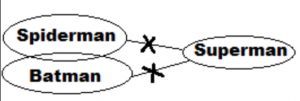
Solution: Only II is true as it is already given in the statement that No Superman is Batman.
Que.2 Statements:
No Whatsapp is Instagram.
No Instagram is twitter.
All twitter are Facebook.
Conclusions:
I. No twitter is Whatsapp.
II. No Facebook is Instagram.
III. No Facebook is Whatsapp.
IV. All Facebook are twitter.
(a) None follows
(b) Only I and II follow
(c) Only III and IV follow
(d) All follows
Ans.(a)

Solution: From the Venn diagram we can clearly see that no conclusion follows.
Que.3 Statements:
I. All cities are towns.
II. Some cities are villages.
Conclusions:
I. All villages are towns.
II. No village is a town.
III. Some villages are towns.
(a) Only conclusion (III) follows
(b) Only conclusion (I) follows
(c) Only conclusion (II) follows
(d) None of these
Ans.(a)
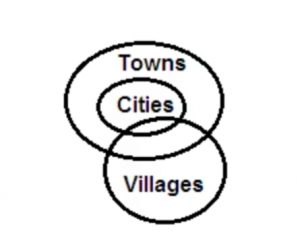
Solution: Only conclusion III follow.
Que.4 Statements:
All mobile are laptop.
Some mobile are watch.
Conclusions:
I. All mobile are watch.
II. Some watch are laptop.
(a) If only conclusion I follows
(b) If only conclusion II follows
(c) If either conclusion I or II follows
(d) If neither conclusion I nor II follow
Ans.(b)
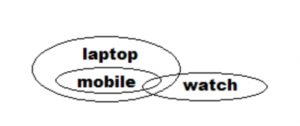
Solution: From the Venn diagram we can infer that conclusion I is definitely false. And as all mobile are laptop and some mobile are watch we can say that some watch are laptop is true.
Que.5 Statements:
No gentleman is poor.
All gentlemen are rich.
Conclusions:
I. No poor man is rich.
II. No rich man is poor.
(a) If only conclusion I follows
(b) If only conclusion II follows
(c) If either conclusion I or II follows
(d) If neither conclusion I nor II follow
Ans.(d)
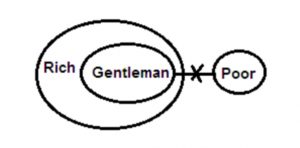
Solution: From the Venn diagram we can see that both the conclusions I and II are not true for all the cases. Hence both I and II do not follow.
Que.6 Statements:
No magazine is cap.
All caps are cameras.
Conclusions:
I. No camera is magazine.
II. Some cameras are magazines.
(a) If only conclusion I follows
(b) If only conclusion II follows
(c) If either conclusion I or II follows
(d) If neither conclusion I nor II follow
Ans.(c)
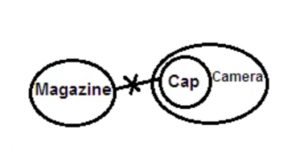
Solution: From the Venn diagram we can see that after considering all the cases either conclusion I or II will be true.
Que.7 Statements:
All doors are buses.
All buses are leaf.
No leaf is a flower.
Conclusions:
I. No flower is a door.
II. No flower is a bus.
III. Some leaves are doors.
IV. Some leaves are buses.
(a) None follows
(b) Only I and II follow
(c) Only II and III follow
(d) All follow
Ans.(d)
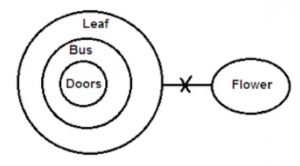
Solution: From the Venn diagram we can clearly see that all conclusions I, II, III and IV follows.
Que.8 Statements
I. Some skies are rain.
II. Some rain are stars.
III. All stars are planets.
IV. All planets are clouds.
Conclusions:
I. Some clouds are rain.
II. Some planets are skies
III. Some planets are rain
(a) Only I and II follow
(b) Only I and III follow
(c) Only II and III follow
(d) I, II and III follow
Ans.(b)
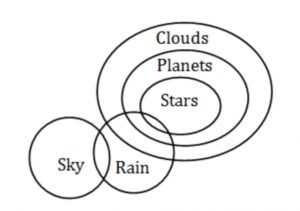
Solution: Some planets are skies is not true for all the possible cases, so Conclusion II is false and cannot be definitely drawn. Conclusions I and III can be definitely drawn from the Venn Diagram obtained from given set of statements.
Que.9 Statements:
I. Some cats are clouds.
II. Dog is a cat.
Conclusions:
I. Some clouds are cats.
II. Dog is not a cloud.
(a) Conclusion I follows
(b) Conclusions II follows
(c) Either conclusion I or II follows
(d) Neither conclusions I nor II follows
Ans.(a)
Sol.
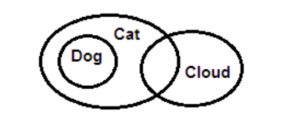
Que.10 Statements :
All bags are chalks.
All chalks are bottles.
Conclusions :
I. Some bottles are bags.
II. All bags are bottles.
III. All bottles are bags.
IV. Some chalks are not bags is a possibility.
(a) Only I, II and IV follow
(b) Only I III and IV follow
(c) Only II, III and IV follow
(d) All follow
Ans.(a)
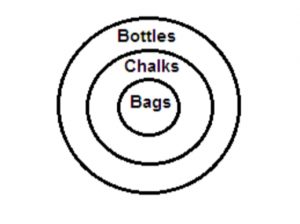
Que.11 Statements:
All girls are dolls.
All dolls are sweet.
Conclusions :
I. Some sweet are girls.
II. All girls are sweet.
III. All sweet are girls.
IV. All sweet are dolls.
(a) Only I and II
(b) Only I III and IV follow
(c) Only II, III and IV follow
(d) All follow
Ans.(a)
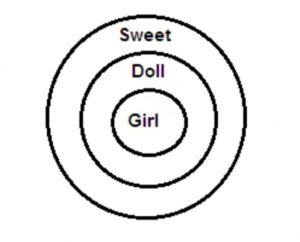
Que.12 Statements:
Some doctors are fools.
Some fools are rich.
Conclusions:
I. Some doctors are rich.
II. Some rich are doctors.
(a) If only conclusion I follows
(b) If only conclusion II follows
(c) If either conclusion I or II follows
(d) If neither conclusion I nor II follow
Ans.(d)
Sol.
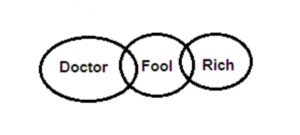
Solution: From the Venn diagram we can see that both the conclusions I and II are not true for all the cases. Hence both I and II do not follow.
We hope these notes on Syllogism Meaning – Types, Tricks, Questions, Solved Examples and Reasoning will help you get a better understanding of Syllogism . And if you want more study notes like this on various topics then stay connected with sscadda.com. And if you want to get these notes in Hindi language then click on the link provided below.

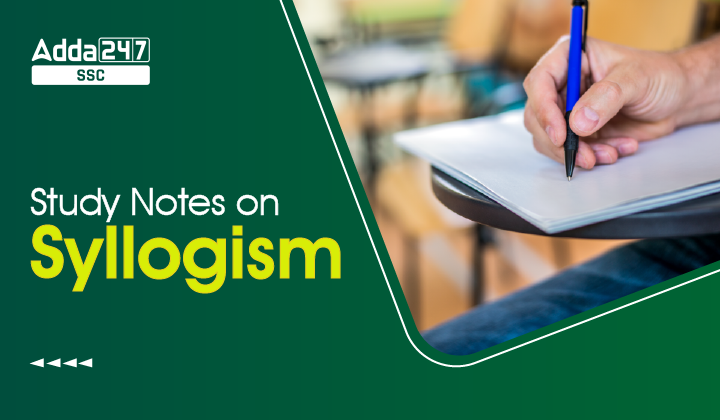






 Free Study Material for SSC CGL 2025, Do...
Free Study Material for SSC CGL 2025, Do...
 Pandit Jawaharlal Nehru, First Prime Min...
Pandit Jawaharlal Nehru, First Prime Min...
 National Animal of India: Royal Bengal T...
National Animal of India: Royal Bengal T...


